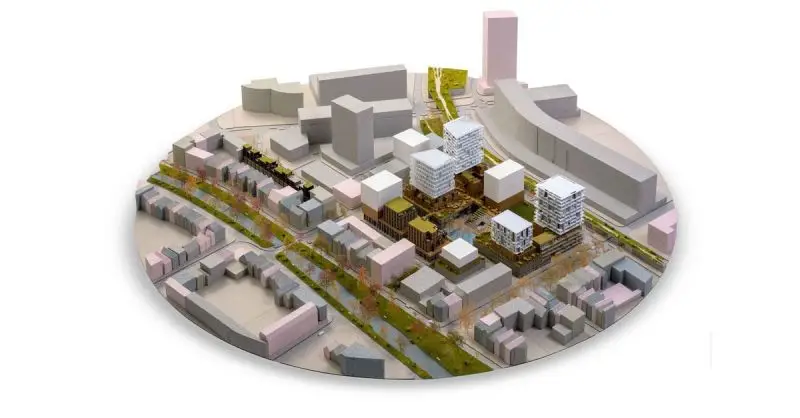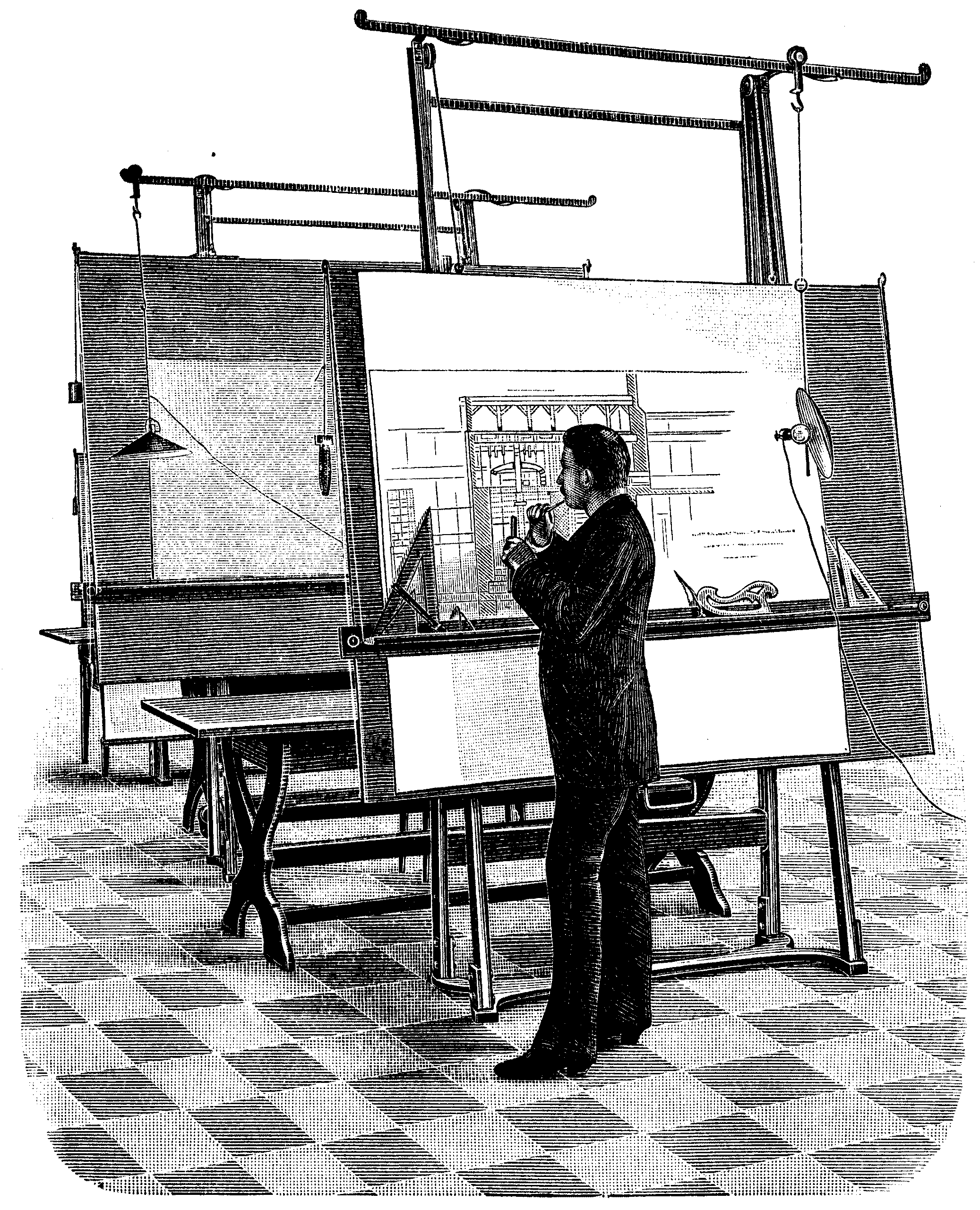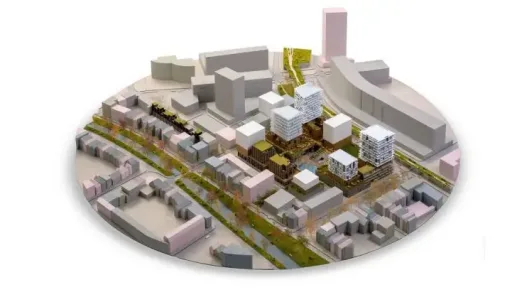In an era characterised by rapid technological advances, architecture has begun to evolve in remarkable ways, largely driven by data. Data-driven design represents a transformative approach that utilises vast amounts of information to inform and enhance architectural practice. This method not only reshapes the way structures are designed and built, but also improves their functionality, sustainability and interaction with users. As architects increasingly adopt this paradigm, the built environment becomes more responsive to the needs of society and the planet.

Definition of Data Centred Design
Data-driven design refers to the practice of using quantitative and qualitative data to guide decision-making in architectural design. This approach integrates a variety of data sources, from demographics to environmental metrics, to inform every stage of a project from conceptualisation to implementation. By leveraging data, architects can create spaces that are not only aesthetically pleasing, but also optimise performance, enhance the user experience and promote sustainability.
Historical Context
The roots of data-driven design date back to the early days of architecture, when builders relied on empirical observations and rudimentary calculations to shape their artefacts. However, the modern interpretation of this concept began to take shape in the late 20th century as computers became more prevalent in design practice. The introduction of Building Information Modelling (BIM) in the 1990s was a major turning point, allowing architects to visualise and manipulate data in ways previously unimaginable. As technology continues to advance, the integration of Geographic Information Systems (GIS) and data analysis tools has further enriched the design process, enabling more informed and context-sensitive architectural solutions.
Importance in Modern Architecture
In today’s fast-paced world, the importance of data-driven design cannot be overstated. As urban populations grow and climate change poses unprecedented challenges, architects must design buildings that are not only functional but also resilient and sustainable. Data-driven design enables architects to analyse patterns and trends that enable them to make smarter, environmentally responsible decisions. This approach can lead to energy-efficient designs, optimised space utilisation and improved user well-being. Moreover, by understanding user behaviour through data, architects can create spaces that foster community and improve overall quality of life.
Overview of Key Technologies
The data-driven design environment is supported by various technologies that facilitate data collection, analysis and visualisation. Sensors placed in buildings can monitor environmental conditions, while mobile applications can collect user feedback and preferences. Virtual reality (VR) and augmented reality (AR) technologies allow architects to simulate spaces and analyse how data affects user interactions. In addition, artificial intelligence (AI) plays a crucial role in processing large datasets, identifying patterns and building predictive models that can significantly influence design decisions. Together, these technologies create a robust framework for architects to effectively utilise data in their creative processes.
The Role of Big Data in Architecture
Big data has emerged as a game-changer in the field of architecture by providing previously inaccessible insights. With the ability to analyse massive datasets, architects can uncover trends in urban development, social behaviour and environmental changes. For example, understanding traffic patterns can guide the siting of new buildings, while analysing climate data can inform energy-efficient designs. Real-world applications of big data in architecture include smart cities initiatives, where data from a variety of sources is integrated to enhance urban living, and adaptive reuse projects that redesign existing structures according to the needs of society. By harnessing the power of big data, architects can create spaces that are not only innovative but also deeply responsive to the complexities of modern life.
In short, data-driven design is revolutionising architecture and enabling professionals to create spaces informed by a wealth of information. As technology continues to advance, the potential of data-driven approaches in architecture will increase, enabling more intelligent, sustainable and user-centred designs.
In the ever-evolving architectural landscape, the integration of technology has transformed the way buildings are designed, constructed and experienced. Data-driven design has emerged as a powerful approach that allows architects to utilise the vast amount of information available to create spaces that are not only aesthetically pleasing, but also functional and sustainable. By leveraging a variety of technologies, this modern methodology enables architects to make informed decisions that enhance the user experience, optimise resources and respond to challenges such as urbanisation and climate change. Architects are redefining the future of our built environment by embracing the information age.
Key Technologies in Data-Driven Architecture
As architects delve deeper into data-driven design, they are increasingly using several key technologies that enhance their creative processes and improve project outcomes. These technologies serve as tools for visualisation, analysis and collaboration and are reshaping the way architects approach their work and interact with clients and communities.
Building Information Modelling (BIM)
Building Information Modelling (BIM) is a revolutionary approach that is transforming the architecture, engineering and construction (AEC) industries. At its core, BIM involves creating a digital representation of a building’s physical and functional characteristics. This three-dimensional model contains detailed information about materials, structural elements and systems, allowing architects to visualise their designs in a comprehensive way.
BIM facilitates collaboration between various stakeholders, including architects, engineers, contractors and clients. By sharing a single, up-to-date model, everyone involved has access to the same information, reducing misunderstandings and errors in the construction process. The technology also supports simulation and analysis, enabling architects to assess factors such as energy efficiency, lighting and structural integrity before construction begins. As a result, BIM not only facilitates project delivery but also contributes to more sustainable building practices.
Geographic Information Systems (GIS)
Geographic Information Systems (GIS) play a crucial role in data-driven architecture by providing spatial analysis and mapping capabilities. Through GIS, architects can analyse geographic data to understand the context of a project site, including topography, climate, zoning regulations and existing infrastructure. This information is invaluable for making informed decisions about site selection, design orientation and environmental impact.
For example, when designing a new urban development, architects can use GIS to assess how the project will interact with the surrounding community and natural landscape. By analysing factors such as traffic patterns, demographics and land use, architects can create designs that are more integrated and responsive to the needs of the area. GIS also supports disaster management and resilience planning, helping architects design buildings that can withstand natural disasters, taking into account historical data and risk assessments.
Artificial Intelligence in Design
Artificial Intelligence (AI) is making waves in architecture by empowering the design process with advanced computational capabilities. AI algorithms can analyse large datasets to identify patterns and generate design alternatives that humans cannot easily grasp. This technology can help architects optimise layouts, improve energy efficiency and even predict user behaviour.
For example, AI-driven tools can automate repetitive tasks such as creating multiple design iterations or assessing compliance with building regulations. This allows architects to focus on the creative aspects of their work while ensuring that their designs meet the required standards. AI can also inform future projects by analysing user feedback and performance data from existing buildings. By integrating artificial intelligence into the design process, architects can create innovative solutions that address the complexities of modern life.
Virtual Reality and Augmented Reality
Virtual Reality (VR) and Augmented Reality (AR) are transforming the way architects present their designs and interact with clients. These immersive technologies enable architects to create virtual impressions of their projects, allowing clients to experience spaces before they are built. This not only helps clients visualise the final product, but also facilitates meaningful feedback early in the design process.
For example, during a design presentation, an architect can use VR to immerse clients in a virtual representation of their future home, allowing them to explore different design elements and spatial configurations. AR, on the other hand, overlays digital information over the physical world, allowing architects and clients to visualise how a proposed building would look in its actual location. This interactive approach encourages collaboration and ensures that the final design is aligned with the customer’s vision and needs.
Cloud Computing and Collaboration
Cloud computing has revolutionised the way architects collaborate on projects by providing a platform for seamless sharing of data and resources. Cloud-based tools allow architects to work together from different locations and access project files and models in real time. This flexibility is particularly valuable in today’s globalised world, where teams are often made up of professionals from different disciplines and regions.
By utilising cloud technology, architects can streamline communication and ensure that everyone is on the same page throughout the project lifecycle. This collaborative environment encourages innovation and creativity, as team members can easily share ideas, feedback and resources. Furthermore, cloud computing improves data security and accessibility, allowing architects to protect sensitive project information and enable remote access.
As a result, the integration of these key technologies into data-driven architecture is reshaping the profession. As architects continue to embrace the information age, they are better equipped to design spaces that meet the needs of communities while addressing broader societal challenges. Through innovative tools and collaborative practices, architects are not only honing their craft, but also paving the way for a more sustainable and responsive built environment.
As we move towards the Information Age, architects are increasingly turning to data-driven design to inform their projects. This approach draws on data from a variety of sources such as environmental studies, user behaviour and urban analysis to create buildings that are not only aesthetically pleasing but also functional and sustainable. By integrating technology and data analysis into the design process, architects can respond more effectively to the needs of the environment and the people living in these spaces. In this section, we will examine important case studies that exemplify the principles of data-driven architecture.
Data Driven Architecture Project Case Studies
The Edge, Amsterdam
The Edge in Amsterdam is often referred to as one of the most advanced office buildings in the world. Designed by architecture firm PLP Architecture, this project utilises a wealth of data to improve the working environment. The building contains a comprehensive array of sensors that monitor everything from lighting to temperature and even employee movement. This data provides a highly adaptable working environment where spaces can be adjusted in real time to meet the needs of the occupants.
One of the highlights of The Edge is its commitment to sustainability. The building is equipped with solar panels and a green roof, which contribute to energy efficiency. The data collected not only informs the design, but also continues to optimise the performance of the building over time. This approach not only reduces operating costs, but also creates a healthier workspace and demonstrates how data can drive sustainable architectural practices.
Bosco Verticale, Milan
The Bosco Verticale, or “Vertical Forest”, in Milan is a striking example of how data can inform ecological architecture. Designed by Stefano Boeri Architetti, this residential project features two towers planted with more than 9,000 trees and 20,000 plants. The design was influenced by local climate and biodiversity data, allowing the selected vegetation to thrive in the urban environment.
The project addresses various current challenges such as air pollution and urban heat islands. Using data to select and position vegetation, the architects created a microclimate that increases biodiversity and improves air quality. This living architecture not only provides aesthetic value, but also demonstrates the building’s commitment to sustainability by reducing its carbon footprint and encouraging urban greening.
The Crystal, London
Located in London’s Royal Victoria Dock, The Crystal is a pioneering centre for sustainability and innovation. The building serves as a hub for sustainable urban development discussions and its design is deeply grounded in data-driven principles. Crystal is powered by renewable energy sources and its construction utilised extensive environmental assessments.
Inside the building, interactive exhibits educate visitors about sustainable practices. The design incorporates smart technologies for energy management, allowing for real-time monitoring and control of resources. By using data to inform both its business and educational initiatives, The Crystal exemplifies how architecture can promote a better understanding of sustainability among the public.
One World Trade Centre, New York
One World Trade Centre, also known as the Freedom Tower, stands as a symbol of resilience and innovation in New York City. The design process for this iconic structure involved extensive data analysis to meet safety, environmental and aesthetic requirements. The architects used simulations to optimise the building’s form, ensuring it can withstand extreme weather conditions and potential threats.
The building includes a state-of-the-art energy management system that collects data on energy use and allows for adjustments that improve efficiency. The tower also features an advanced ventilation system that improves indoor air quality. Through this data integration, One World Trade Centre serves not only as a monument but also as a model for future skyscrapers, demonstrating how data-driven design can improve safety and efficiency.
Green Building, Boston
The Green Building at MIT in Boston is a landmark in sustainable architecture. Designed by the Payette architecture firm, this facility demonstrates the potential of data-driven design in educational environments. The building’s design process analyses data on energy consumption, daylight and user behaviour to create a space that encourages collaboration and innovation.
The Green Building features a high-performance façade that adapts to changing weather conditions, maximising natural light while minimising energy use. Inside, the layout encourages interaction between students and faculty, creating a sense of community. By prioritising data in its design, the Green Building not only achieves its sustainability goals, but also enhances the educational experience, demonstrating the transformative power of data-driven architecture.
In conclusion, these case studies highlight various applications of data-driven design in contemporary architecture. Ranging from improving sustainability and efficiency to fostering community and resilience, these projects demonstrate how architects are utilising data to create spaces that respond to the needs of both individuals and the environment. As technology continues to evolve, the potential for data-driven design in architecture will increase, resulting in even more innovative solutions for the challenges of the modern world.
In a world increasingly defined by technology and data, architects are finding innovative ways to integrate information into their design processes. More than just a trend, data-driven design (DDD) represents a significant shift in the way architects approach their projects. By harnessing the power of data, they can create structures that are not only visually appealing, but also functional, sustainable and user-centred. This section explores the numerous benefits of data-driven design and highlights its transformative impact on the architectural environment.
Benefits of Data-Driven Design
The benefits of data-driven design are profound and multifaceted. As architects adopt this modern approach, new potentials emerge in efficiency, sustainability, user experience, resource management and decision-making.
Improved Efficiency and Productivity
One of the main advantages of data-driven design is its ability to increase efficiency and productivity. Using data analytics, architects can streamline workflows and reduce the time it takes to conceptualise and implement designs. For example, software tools that analyse environmental factors such as sunlight exposure and wind patterns allow architects to optimise layouts before the first brick is laid. This proactive approach minimises revisions and rework, resulting in faster project completion. Data can also help identify potential bottlenecks in the design process, enabling teams to allocate resources more effectively and maintain momentum.
Improved Sustainability Practices
Sustainability is a major concern in architecture today, and data-driven design plays a crucial role in addressing this challenge. By analysing data on energy consumption, material use and environmental impacts, architects can make informed choices to reduce a building’s carbon footprint. For example, data can reveal the most sustainable materials for a given climate and help architects choose options that are not only environmentally friendly but also cost-effective. Buildings designed with data insights can significantly reduce energy costs and contribute to a more sustainable future for urban development by promoting a healthier environment.
Greater User Experience and Comfort
User experience is at the heart of architectural design, and data-driven design allows architects to prioritise the needs and preferences of building occupants. By collecting data on how spaces are used, such as foot traffic patterns and user feedback, architects can create environments that promote comfort and functionality. For example, analysing data from smart building technologies can inform decisions about layout, lighting and acoustics, ensuring that spaces are not only aesthetically pleasing but also conducive to wellbeing. This focus on user experience leads to happier occupants and more successful buildings.
Cost Reduction and Resource Management
In an era when budgets are often tight, data-driven design offers architects practical solutions for cost reduction and resource management. By leveraging data analytics, they can more accurately estimate costs, identify potential overruns and optimise material usage. This approach helps avoid waste and enables better planning for future maintenance. For example, using predictive analytics, architects can estimate the lifetime of materials and systems, enabling smarter investment in durable options. This foresight not only saves money, but also extends the life of buildings, creating a win-win for both customers and the environment.
Data Driven Decision Making
At its core, data-driven design empowers architects to make informed decisions based on concrete evidence rather than just intuition. With access to a wealth of data, from demographics to climate patterns, architects can tailor their designs to meet the specific needs of a community or project. This evidence-based approach minimises risks and improves outcomes by basing decisions on reliable information. For example, data can reveal trends in urban development and guide architects to create spaces that are not only timely but also future-proof.
As a result, the benefits of data-driven design are reshaping the architectural landscape. By increasing efficiency, promoting sustainability, enhancing user experience, reducing costs, and encouraging informed decision-making, architects are becoming better equipped to meet the challenges of the modern world. As this approach continues to evolve, it promises to redefine how we think about and relate to the built environment, paving the way for smarter, more adaptable designs that serve both people and planet.
In the ever-evolving world of architecture, the integration of data into design processes has ushered in a new era of creativity and efficiency. Data-driven design enables architects to make more informed decisions and create spaces that suit the needs of users. However, as with any revolutionary approach, there are challenges and limitations to overcome. Understanding these barriers is crucial for architects who want to fully embrace the potential of data.
Challenges and Limitations
While data-driven design offers many benefits, it is not without its obstacles. These challenges can affect how effectively architects can utilise data in their projects. Addressing these issues is crucial to the successful implementation of data-driven methodologies in architecture.
Data Privacy and Security Concerns
As architects begin to utilise large amounts of data, especially personal information about users and communities, privacy and security concerns arise. For example, when designing a public space, architects may collect data on foot traffic patterns or demographic information. This data can improve the design, but it also raises questions about who has access to it and how it is stored. If sensitive information is mishandled, it can lead to serious consequences for both users and the company. Ensuring that data practices are compliant with regulations such as GDPR in Europe is crucial to maintaining trust and protecting privacy. Architects should prioritise developing secure systems and transparent data policies to mitigate these risks.
Integration of New Technologies
The architectural environment is increasingly influenced by advanced technologies such as Building Information Modelling (BIM), virtual reality (VR) and artificial intelligence (AI). While these tools have the potential to revolutionise design processes, integrating them into existing workflows can be challenging. Many firms may struggle to have the technical know-how required to utilise these tools effectively, leading to potential delays or misunderstandings in project development. Furthermore, the rapid pace of technological advancement means that architects must constantly adapt and learn, which can be a daunting task. Successful integration requires not only training and resources, but also a culture that embraces innovation and flexibility.
Data Quality Dependency
The effectiveness of data-driven design depends on the quality of the data used. Poor quality data can lead to incorrect design decisions and result in spaces that do not serve their purpose. For example, if an architect relies on outdated or inaccurate data about user preferences, the final design may not meet the needs of the people who will use it. This underlines the importance of rigorous data collection and analysis processes. Architects should be diligent in verifying the accuracy and relevance of data sources to ensure that the information guiding their designs is both current and comprehensive.
Resistance to Change in Traditional Practices
The architectural industry has long-established traditions and practices that have evolved over centuries. Many professionals may be hesitant to adopt data-driven methodologies and see them as a departure from established norms. This resistance may stem from fear of the unknown or a lack of understanding of the benefits that data can provide. For example, some may worry that data-driven approaches may stifle creativity or reduce the human element in design. To overcome this challenge, it is vital to develop a dialogue about the value of data in enhancing rather than replacing traditional architectural practices. A more harmonious integration can be achieved by showing how data can complement intuition and creativity.
Potential for Over Reliance on Technology
As architects embrace data-driven design, there is a risk of becoming overly dependent on technology. While data and algorithms can provide valuable insights, they cannot replace the nuanced understanding that comes from human experience and creativity. For example, an algorithm may suggest a design based on patterns in user behaviour, but may not take into account the emotional or cultural significance of a space. Architects must strike a balance when using data as a tool to inform their decisions, while making room for personal expression and innovative thinking. Achieving this balance is essential to creating spaces that are not only functional but also resonate more deeply with users.
In conclusion, while data-driven design presents exciting opportunities for architects, it also presents challenges that require careful consideration. Architects can overcome the complexities of the information age by addressing concerns about data privacy, technology integration, data quality, resistance to change, and potential overreliance on technology. Embracing these challenges will ultimately lead to more thoughtful, responsive and innovative architectural solutions that enhance the built environment for all.
The Future of Data-Driven Design in Architecture
As we move towards the Information Age, architecture finds itself at the intersection of technology and creativity. Data-driven design is not just a trend; it represents a fundamental shift in the way architects approach their work. By utilising large amounts of data, architects can create spaces that are not only aesthetically pleasing, but also functional and responsive to human needs. This section explores the future of data-driven design in architecture and highlights emerging trends, educational requirements, innovative insights, interdisciplinary collaboration and the implications of smart cities.
Emerging Trends to Watch
The world of architecture is evolving rapidly, influenced by advances in technology and changing societal needs. A key trend is the increasing use of artificial intelligence (AI) in the design process. AI can analyse large data sets to predict how a space will be used, allowing architects to create designs that enhance the user experience. For example, AI algorithms can simulate pedestrian traffic in a building, helping architects optimise layouts for better flow and accessibility.
Another trend is the integration of virtual and augmented reality (VR/AR) tools. These technologies enable architects to create immersive experiences, allowing clients to visualise projects before they are built. This not only increases client engagement, but also facilitates more informed decision-making. As these technologies become more accessible, we can expect to see an increase in their application at various stages of the design process.
Sustainability is also becoming a central focus in data-driven architecture. Architects are now using data to assess environmental impact, energy efficiency and resource management. Using tools such as Building Information Modelling (BIM), architects are able to analyse the life cycle of materials and optimise designs to reduce their carbon footprint. This shift towards sustainable practices is not just a trend; it reflects a broader societal commitment to tackling climate change.
The Role of Education and Training
As the field of architecture embraces data-driven design, education and training must evolve to prepare future architects for these changes. Traditional curricula are being enhanced with courses focusing on data analytics, computational design and digital fabrication. Universities are increasingly offering interdisciplinary programmes that combine architecture with data science, engineering and environmental studies.
Also, hands-on experience with the latest technologies is crucial. Students are encouraged to participate in collaborative projects using artificial intelligence, virtual reality and data analysis tools. By fostering an environment where students can experiment with these technologies, educational institutions are preparing them for the realities of contemporary architecture.
Continuing education is also crucial for practising architects. As technology advances, professionals must stay up-to-date on the latest tools and methodologies. Workshops, online courses and professional certifications can help architects develop their skill sets, enabling them to remain competitive in a rapidly changing industry.
Insights for Architectural Innovation
Looking ahead, we can expect various innovations that will further redefine architecture. One exciting possibility is the development of smart materials that dynamically respond to environmental changes. Imagine buildings that can adjust their insulation properties in response to temperature fluctuations and optimise energy use in real time. These innovations can lead to more efficient and sustainable buildings, enabling a significant step forward in architectural design.
Furthermore, the integration of the Internet of Things (IoT) into architecture will create more interactive and responsive spaces. Buildings equipped with smart sensors can collect data on occupancy, air quality and energy consumption, enabling real-time adjustments that improve comfort and efficiency. This shift towards smart buildings will fundamentally change the way we experience and interact with our environment.
Moreover, as urban populations continue to grow, architects will need to innovate in creating shared spaces that encourage social interaction. Data-driven insights can guide the design of parks, plazas and public spaces that meet the needs of diverse populations and promote inclusion and well-being.
Interdisciplinary Collaboration
The future of data-driven design in architecture will increasingly rely on collaboration between various disciplines. Architects, engineers, urban planners, data scientists and environmental specialists will need to work together to produce holistic solutions. This interdisciplinary approach enables teams to draw on different perspectives, resulting in designs that are both innovative and practical.
For example, collaboration between architects and urban planners is essential in the development of smart city initiatives. By combining their expertise, they can create urban spaces that are not only functional but also sustainable and liveable. This collaboration goes beyond the design phase and includes ongoing dialogue throughout the construction and operation of the buildings.
Furthermore, the integration of feedback from end-users will also play a crucial role. Data-driven design emphasises the importance of understanding user behaviour and preferences. By involving community members in the design process, architects can ensure that their projects meet real needs and foster a sense of ownership and participation.
Impact of Smart Cities
Smart cities represent a transformative vision for urban living, and data-driven architecture is at the forefront of this movement. By harnessing data and technology, cities can improve the quality of life for their residents while promoting sustainability and efficiency. Architects play a vital role in this transformation by designing buildings and public spaces that integrate seamlessly with smart infrastructure.
One of the most important benefits of smart cities is the potential for improved resource management. For example, data from smart sensors can inform city planners about traffic patterns, energy use and waste management. This information enables resources to be allocated more efficiently, reducing costs and environmental impacts.
Moreover, smart cities prioritise connectivity and accessibility. Data-driven designs can facilitate the creation of pedestrian-friendly spaces, efficient public transport systems and inclusive community spaces. As urban areas continue to evolve, architects will be instrumental in shaping environments that are not only technologically advanced, but also human-centred.
In conclusion, the future of data-driven design in architecture is bright and full of possibilities. By adapting to emerging trends, investing in education, encouraging interdisciplinary collaboration and embracing the smart city movement, architects can create innovative spaces that respond to the complexities of modern life. This approach not only improves the built environment, but also enriches the human experience, making architecture a true reflection of our evolving society.





















